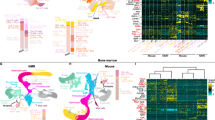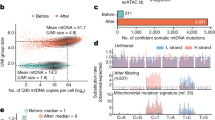Abstract
The proapoptotic BCL-2 family proteins BAX and BAK serve as essential gatekeepers of the intrinsic apoptotic pathway and, when activated, transform into pore-forming homo-oligomers that permeabilize the mitochondrial outer membrane. Deletion of Bax and Bak causes marked resistance to death stimuli in a variety of cell types. Bax−/−Bak−/− mice are predominantly non-viable and survivors exhibit multiple developmental abnormalities characterized by cellular excess, including accumulation of neural progenitor cells in the periventricular, hippocampal, cerebellar and olfactory bulb regions of the brain. To explore the long-term pathophysiological consequences of BAX/BAK deficiency in a stem cell niche, we generated Bak−/− mice with conditional deletion of Bax in Nestin-positive cells. Aged NestinCreBaxfl/flBak−/− mice manifest progressive brain enlargement with a profound accumulation of NeuN- and Sox2-positive neural progenitor cells within the subventricular zone (SVZ). One-third of the mice develop frank masses comprised of neural progenitors, and in 20% of these cases, more aggressive, hypercellular tumors emerged. Unexpectedly, 60% of NestinCreBaxfl/flBak−/− mice harbored high-grade tumors within the testis, a peripheral site of Nestin expression. This in vivo model of severe apoptotic blockade highlights the constitutive role of BAX/BAK in long-term regulation of Nestin-positive progenitor cell pools, with loss of function predisposing to adult-onset tumorigenesis.
This is a preview of subscription content, access via your institution
Access options
Subscribe to this journal
Receive 50 print issues and online access
$259.00 per year
only $5.18 per issue
Buy this article
- Purchase on Springer Link
- Instant access to full article PDF
Prices may be subject to local taxes which are calculated during checkout





Similar content being viewed by others
References
Youle RJ, Strasser A . The BCL-2 protein family: opposing activities that mediate cell death. Nat Rev Mol Cell Biol 2008; 9: 47–59.
Wei MC, Zong WX, Cheng EH, Lindsten T, Panoutsakopoulou V, Ross AJ et al. Proapoptotic BAX and BAK: a requisite gateway to mitochondrial dysfunction and death. Science 2001; 292: 727–730.
Tait SW, Green DR . Mitochondria and cell death: outer membrane permeabilization and beyond. Nat Rev Mol Cell Biol 2010; 11: 621–632.
Lindsten T, Ross AJ, King A, Zong WX, Rathmell JC, Shiels HA et al. The combined functions of proapoptotic Bcl-2 family members bak and bax are essential for normal development of multiple tissues. Mol Cell 2000; 6: 1389–1399.
Yip KW, Reed JC . Bcl-2 family proteins and cancer. Oncogene 2008; 27: 6398–6406.
Yin C, Knudson CM, Korsmeyer SJ, Van Dyke T . Bax suppresses tumorigenesis and stimulates apoptosis in vivo. Nature 1997; 385: 637–640.
Shibata MA, Liu ML, Knudson MC, Shibata E, Yoshidome K, Bandey T et al. Haploid loss of bax leads to accelerated mammary tumor development in C3(1)/SV40-TAg transgenic mice: reduction in protective apoptotic response at the preneoplastic stage. EMBO J 1999; 18: 2692–2701.
Dansen TB, Whitfield J, Rostker F, Brown-Swigart L, Evan GI . Specific requirement for Bax, not Bak, in Myc-induced apoptosis and tumor suppression in vivo. J Biol Chem 2006; 281: 10890–10895.
Degenhardt K, Chen G, Lindsten T, White E . BAX and BAK mediate p53-independent suppression of tumorigenesis. Cancer Cell 2002; 2: 193–203.
Kirsch DG, Dinulescu DM, Miller JB, Grimm J, Santiago PM, Young NP et al. A spatially and temporally restricted mouse model of soft tissue sarcoma. Nat Med 2007; 13: 992–997.
Rampino N, Yamamoto H, Ionov Y, Li Y, Sawai H, Reed JC et al. Somatic frameshift mutations in the BAX gene in colon cancers of the microsatellite mutator phenotype. Science 1997; 275: 967–969.
Meijerink JP, Mensink EJ, Wang K, Sedlak TW, Sloetjes AW, de Witte T et al. Hematopoietic malignancies demonstrate loss-of-function mutations of BAX. Blood 1998; 91: 2991–2997.
Cartron PF, Oliver L, Martin S, Moreau C, LeCabellec MT, Jezequel P et al. The expression of a new variant of the pro-apoptotic molecule Bax, Baxpsi, is correlated with an increased survival of glioblastoma multiforme patients. Hum Mol Genet 2002; 11: 675–687.
Lindsten T, Golden JA, Zong WX, Minarcik J, Harris MH, Thompson CB . The proapoptotic activities of Bax and Bak limit the size of the neural stem cell pool. J Neurosci 2003; 23: 11112–11119.
Takeuchi O, Fisher J, Suh H, Harada H, Malynn BA, Korsmeyer SJ . Essential role of BAX, BAK in B cell homeostasis and prevention of autoimmune disease. Proc Natl Acad Sci USA 2005; 102: 11272–11277.
Reyes NA, Fisher JK, Austgen K, VandenBerg S, Huang EJ, Oakes SA . Blocking the mitochondrial apoptotic pathway preserves motor neuron viability and function in a mouse model of amyotrophic lateral sclerosis. J Clin Invest 2010; 120: 3673–3679.
Ligon KL, Huillard E, Mehta S, Kesari S, Liu H, Alberta JA et al. Olig2-regulated lineage-restricted pathway controls replication competence in neural stem cells and malignant glioma. Neuron 2007; 53: 503–517.
Mehta S, Huillard E, Kesari S, Maire CL, Golebiowski D, Harrington EP et al. The central nervous system-restricted transcription factor Olig2 opposes p53 responses to genotoxic damage in neural progenitors and malignant glioma. Cancer Cell 2011; 19: 359–371.
Amoh Y, Yang M, Li L, Reynoso J, Bouvet M, Moossa AR et al. Nestin-linked green fluorescent protein transgenic nude mouse for imaging human tumor angiogenesis. Cancer Res 2005; 65: 5352–5357.
Knudson CM, Tung KS, Tourtellotte WG, Brown GA, Korsmeyer SJ . Bax-deficient mice with lymphoid hyperplasia and male germ cell death. Science 1995; 270: 96–99.
Davidoff MS, Middendorff R, Enikolopov G, Riethmacher D, Holstein AF, Muller D . Progenitor cells of the testosterone-producing Leydig cells revealed. J Cell Biol 2004; 167: 935–944.
Lobo MV, Arenas MI, Alonso FJ, Gomez G, Bazan E, Paino CL et al. Nestin, a neuroectodermal stem cell marker molecule, is expressed in Leydig cells of the human testis and in some specific cell types from human testicular tumours. Cell Tissue Res 2004; 316: 369–376.
Dubois NC, Hofmann D, Kaloulis K, Bishop JM, Trumpp A . Nestin-Cre transgenic mouse line Nes-Cre1 mediates highly efficient Cre/loxP mediated recombination in the nervous system, kidney, and somite-derived tissues. Genesis 2006; 44: 355–360.
McCall MN, Uppal K, Jaffee HA, Zilliox MJ, Irizarry RA . The Gene Expression Barcode: leveraging public data repositories to begin cataloging the human and murine transcriptomes. Nucleic Acids Res 2011; 39: D1011–D1015.
Su AI, Wiltshire T, Batalov S, Lapp H, Ching KA, Block D et al. A gene atlas of the mouse and human protein-encoding transcriptomes. Proc Natl Acad Sci USA 2004; 101: 6062–6067.
Kim J, Woo AJ, Chu J, Snow JW, Fujiwara Y, Kim CG et al. A Myc network accounts for similarities between embryonic stem and cancer cell transcription programs. Cell 2010; 143: 313–324.
Ben-Porath I, Thomson MW, Carey VJ, Ge R, Bell GW, Regev A et al. An embryonic stem cell-like gene expression signature in poorly differentiated aggressive human tumors. Nat Genet 2008; 40: 499–507.
Sauvageot CM, Kesari S, Stiles CD . Molecular pathogenesis of adult brain tumors and the role of stem cells. Neurol Clin 2007; 25: 891–924.
Gil-Perotin S, Marin-Husstege M, Li J, Soriano-Navarro M, Zindy F, Roussel MF et al. Loss of p53 induces changes in the behavior of subventricular zone cells: implication for the genesis of glial tumors. J Neurosci 2006; 26: 1107–1116.
Meletis K, Wirta V, Hede SM, Nister M, Lundeberg J, Frisen J . p53 suppresses the self-renewal of adult neural stem cells. Development 2006; 133: 363–369.
Zheng H, Ying H, Yan H, Kimmelman AC, Hiller DJ, Chen AJ et al. p53 and Pten control neural and glioma stem/progenitor cell renewal and differentiation. Nature 2008; 455: 1129–1133.
al-Ubaidi MR, Font RL, Quiambao AB, Keener MJ, Liou GI, Overbeek PA et al. Bilateral retinal and brain tumors in transgenic mice expressing simian virus 40 large T antigen under control of the human interphotoreceptor retinoid-binding protein promoter. J Cell Biol 1992; 119: 1681–1687.
Eberhart CG, Brat DJ, Cohen KJ, Burger PC . Pediatric neuroblastic brain tumors containing abundant neuropil and true rosettes. Pediatr Dev Pathol 2000; 3: 346–352.
Gessi M, Giangaspero F, Lauriola L, Gardiman M, Scheithauer BW, Halliday W et al. Embryonal tumors with abundant neuropil and true rosettes: a distinctive CNS primitive neuroectodermal tumor. Am J Surg Pathol 2009; 33: 211–217.
Preusser M, Dietrich W, Czech T, Prayer D, Budka H, Hainfellner JA . Rosette-forming glioneuronal tumor of the fourth ventricle. Acta Neuropathol 2003; 106: 506–508.
Burness ML, Sipkins DA . The stem cell niche in health and malignancy. Semin Cancer Biol 2010; 20: 107–115.
Gentleman RC, Carey VJ, Bates DM, Bolstad B, Dettling M, Dudoit S et al. Bioconductor: open software development for computational biology and bioinformatics. Genome Biol 2004; 5: R80.
Carvalho BS, Irizarry RA . A framework for oligonucleotide microarray preprocessing. Bioinformatics 26: 2363–2367.
Smyth GK . Linear models and empirical bayes methods for assessing differential expression in microarray experiments. Stat Appl Genet Mol Biol 2004; 3: Article3.
Benjamini Y, Hochberg Y . Controlling the false discovery rate: a practical and powerful approach to multiple testing. J R Stat Soc 1995; 57: 289–300.
Subramanian A, Tamayo P, Mootha VK, Mukherjee S, Ebert BL, Gillette MA et al. Gene set enrichment analysis: a knowledge-based approach for interpreting genome-wide expression profiles. Proc Natl Acad Sci USA 2005; 102: 15545–15550.
Culhane AC, Schroder MS, Sultana R, Picard SC, Martinelli EN, Kelly C et al. GeneSigDB: a manually curated database and resource for analysis of gene expression signatures. Nucleic Acids Res 2012; 40(Database issue): D1060–D1066.
Acknowledgements
We thank E Smith for editorial and graphics assistance, R Segal, R Folkerth and C Stiles for helpful discussions, and S Rodig and the Harvard Medical School Rodent Histopathology and Brigham and Women's Hospital, Specialized Histopathology cores for technical support. This work was supported by NIH Grants 5R01CA050239 and 1P01CA142536 to LDW, NIH Grant 5K08HL103847 to SGK and the Todd J Schwartz Memorial Fund.
Author information
Authors and Affiliations
Corresponding author
Ethics declarations
Competing interests
The authors declare no conflict of interest.
Additional information
Supplementary Information accompanies the paper on the Oncogene website
Supplementary information
Rights and permissions
About this article
Cite this article
Katz, S., Fisher, J., Correll, M. et al. Brain and testicular tumors in mice with progenitor cells lacking BAX and BAK. Oncogene 32, 4078–4085 (2013). https://doi.org/10.1038/onc.2012.421
Received:
Revised:
Accepted:
Published:
Issue Date:
DOI: https://doi.org/10.1038/onc.2012.421
Keywords
This article is cited by
-
Identification of 22 susceptibility loci associated with testicular germ cell tumors
Nature Communications (2021)
-
Modeling the function of BAX and BAK in early human brain development using iPSC-derived systems
Cell Death & Disease (2020)



